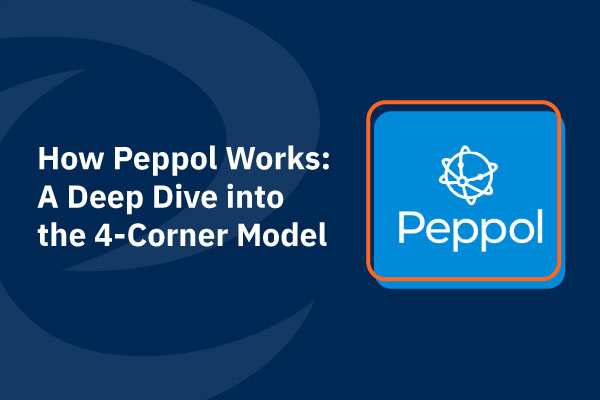How Peppol Works: A Deep Dive into the 4-Corner Model

September 3, 2025
When we talk about e-invoicing flows, we often use corner models to show how documents move between different parties. The idea is the same everywhere: an invoice or another business document needs to get from the sender to the receiver.
The setup can vary from country to country. Some national systems use the Peppol flow as it is, while others adapt it and integrate Peppol into their own local model.
In this blog we focus on Peppol, which is used in many countries to make cross border and domestic trade easier. This blog is all about the Peppol network explained, focusing on the two main flows you might come across when dealing with e-invoicing: the Peppol 4 corner model and the Peppol 5 corner model.
Peppol 4-Corner Model
The 4 corner model is essentially the basic Peppol flow. It is the standard approach in many countries and is designed to make sure business documents are exchanged securely and reliably. In this setup, the document is sent from one Peppol access point to another, with each party connected to their own certified provider in the Peppol network.
Because both sender and receiver can choose their own access point, the model gives flexibility while still ensuring compatibility across the network. In the table below you can see more details about what happens at each corner.
| Corner | Role | What happens here |
| 1 | Sender | Creates the business document in their ERP or accounting system |
| 2 | Sender’s Access Point | Validates and sends the document into the Peppol network |
| 3 | Receiver’s Access Point | Receiver’s Access Point receives the document from the network |
| 4 | Receiver | The receiver gets the document in their own system in a ready-to-use format |
While the 4 corner model is the standard Peppol flow, some countries and industries have added an extra step to meet local requirements. This is where the 5 corner model comes in. It works in much the same way, but with one more “corner” in the process, which can change how documents are routed through the network.
Peppol 5-Corner Model
The Peppol 5 corner model is also referred to as the Peppol CTC (Continuous Transaction Controls) model. It builds on the standard 4 corner flow but adds an extra step in the form of a government platform.
This approach is used in countries that require CTC, where invoices must be validated in real time before they can be delivered to the receiver. In these cases, the document is sent to the government platform for checks and approval before it continues through the Peppol network.
The exact setup varies from country to country, and there can be additional requirements such as specific formats, archiving rules or data reporting. This makes it more complex for companies to ensure fully compliant e-invoicing processes.
| Corner | Role | What happens here |
| 1 | Sender (You) | Creates the business document in their ERP or accounting system |
| 2 | Sender’s Access Point | Validates and sends the document into the Peppol network |
| 3 | Government Platform | Validates, approves and registers the document |
| 4 | Receiver’s Access Point | Receiver’s Access Point receives the document from the network |
| 5 | Receiver | The receiver gets the document in their own system in a ready-to-use format |
Final thoughts about the peppol 4 and 5 corner model
Both the Peppol 4 corner model and the Peppol 5 corner model are becoming increasingly popular, used not only across Europe but also in other regions adopting Peppol for e-invoicing and document exchange. No matter which model your business needs to follow, we as your Peppol access point can ensure your documents move smoothly and securely from sender to receiver.
If you want to learn more about how Peppol works and what it means for your business, check out our other blog, The Complete Guide to Peppol, and of course, feel free to contact us if you need help setting up or managing your Peppol flows.
Share this post:
Stay ahead of the competition
Get expert supply chain insights delivered directly to your inbox weekly.